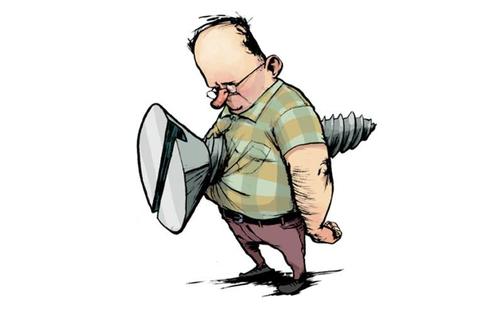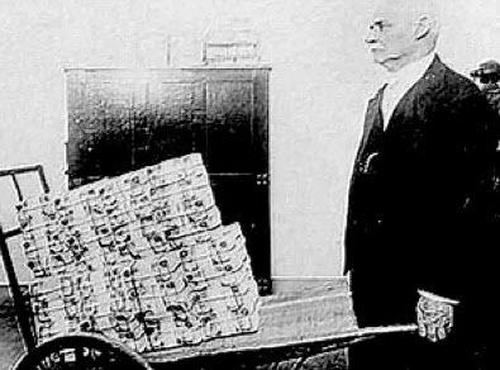Jerome ‘Von Havenstein’: Inflation… Or Bust!
Authored by MN Gordon via EconomicPrism.com,
This week brought forth new evidence that – to be perfectly frank – we’re all screwed.
On Thursday, the yield on the 10 year Treasury note topped 1.55 percent. Subsequently, the Dow Jones Industrial Average, after hitting an all-time high on Wednesday, dropped 559 points. Wall Street must not be listening to Federal Reserve Chairman Jerome Powell.
Earlier in the week, Powell, in testimony to the Senate Banking Committee, confirmed that the central bank would keep the federal funds rate near zero until maximum employment is achieved. In addition, the Fed, in its recently released semiannual Monetary Policy Report, confirmed it would continue to create credit from thin air to buy $80 billion per month of Treasuries and $40 billion per month of mortgage backed securities (MBS).
What’s more, the Report specified the Fed’s purchases of Treasuries and MBS “…will continue at least at this pace until substantial further progress has been made toward its maximum employment and price stability goals.” The operative words being, “at least.”
What to make of it…
Central banking is a form of central planning. And central planning is a form of state control. And state control, as practiced in the United States, pertains not so much to the economics of producing income; but, rather, the methods for redistributing it.
State control, through inflationism, takes money saved and earned by individuals and covertly redistributes it to the central authority – i.e., Washington. There it is consumed by ever expanding government social programs and colossal pentagon budgets. What remains is wasted away by the endless array of bureaucracies and agencies.
Powell, without question, is a man of unyielding principles. His core beliefs align with the central authority. They also align with the twelve regional Federal Reserve Banks, which, according to the Ninth Circuit Court of Appeals, “are independent, privately owned and locally controlled corporations.”
Hence, Powell endeavors to keep Federal Reserve Banks and their member banks flush with cash and liquidity. He also endeavors to provide Washington an endless supply of cheap credit.
The point is, the higher interest rates run, the more Powell will intervene in credit markets, via Treasury and MBS purchases, to hold rates down. The goal of maximum employment is merely a cover for what will be several trillion dollars more in quantitative easing.
Powell, we presume, grasps the importance of history. He surely knows all fiat money is doomed to failure. And he surely knows the dollar’s current place in a fiat money’s lifecycle.
Powell, no doubt, recognizes the dollar’s end is nigh. But what can he really do? He has a tiger by the tail. He can’t reverse course. Like others before him, he must ride it to the bitter end…
The Grandmaster of Monetary Stimulus
Rudolf von Havenstein had been president of the Reichsbank – the German central bank – since 1908. He knew the workings of central bank debt issuances better than anyone. He was a central banker’s central banker. He was good at it.
Thus, when he was called upon by history to deliver a miracle for the Deutches Reich in the aftermath of WWI, he knew exactly what to do. He’d deliver monetary stimulus. In fact, he’d already been at it for several years.
On August 4, 1914, at the start of the war to end all wars, the Goldmark – or gold-backed Reichmark – became the unbacked Papermark. With gold out of the picture, the money supply could be expanded to meet the endless demands of war.
To this end, von Havenstein took public debt from 5.2 billion marks in 1914 to 105.3 billion marks in 1918. Over this time, he increased the quantity of marks from 5.9 billion to 32.9 billion. German wholesale prices rose 115 percent.
By the war’s end, Germany’s economy was in shambles. Industrial production in 1920 had slipped to just 61 percent of the level seen in 1913. With a weak economy, and under the crushing weight of debt, it was time for von Havenstein to really crank up the money printers.
In truth, he didn’t have much of a choice. The limits of fiscal and monetary prudence had been crossed when the Goldmark was replaced with the Papermark. Reversing course now would have brought an immediate economic collapse and societal discord.
Von Havenstein, faced with the choice of post-war depression or inflation, chose what he thought would be the easier softer way. He considered inflation the lesser of two evils. Plus it would lighten Germany’s war debt.
Jerome von Havenstein: Inflation Or Bust
Initially, the ill effects of the Reichsbank’s money supply inflation seemed to be limited. As real, inflation adjusted wages declined, unemployment actually fell to record lows. But, alas, a real McCoy crack-up boom was underway.
As the value of the Papermark continued to decline wage earners were continually shredded. To combat the increasing destruction to wage earners the German government introduced mandatory wage indexing. Upon this government intervention, unemployment immediately soared…running from record lows to record highs within just two years.
At the same time the decline in the Papermark’s purchasing power and external value accelerated until the currency, for all practical purposes, ceased to function as a viable medium of exchange.
Indeed, printing money can be stressful. But printing extreme amounts of money can be downright terminal.
By the time von Havenstein died in late-November 1923 of a myocardial infarction, the central bank of Germany had printed over 500 quintillion marks. Moderate inflation transformed to hyperinflation. One U.S. dollar was worth 4.2 trillion marks by December 1923.
Moreover, the destruction of the mark brought destruction of society…and the rise of national socialism. The medium-term political repercussions of this economic catastrophe soon engulfed the whole world.
Jerome Powell, like Rudolf von Havenstein, knows exactly what he’s doing. In fact, he’s told the world what he’s doing. It’s inflation or bust.
The gold market, which has slumped to below $1,800 per ounce, must think he’s bluffing. This is a mistake. If you understand nothing else understand this: Powell’s pursuit of inflation is as serious as a von Havenstein heart attack.
Tyler Durden
Sat, 02/27/2021 – 13:30
via ZeroHedge News https://ift.tt/2NC2MhZ Tyler Durden

